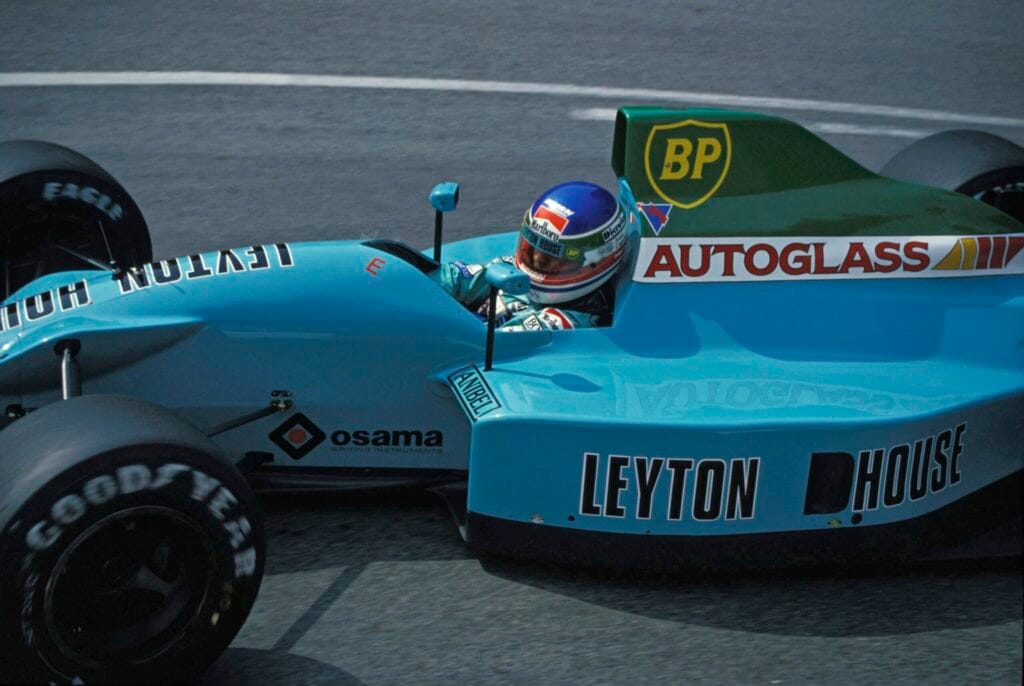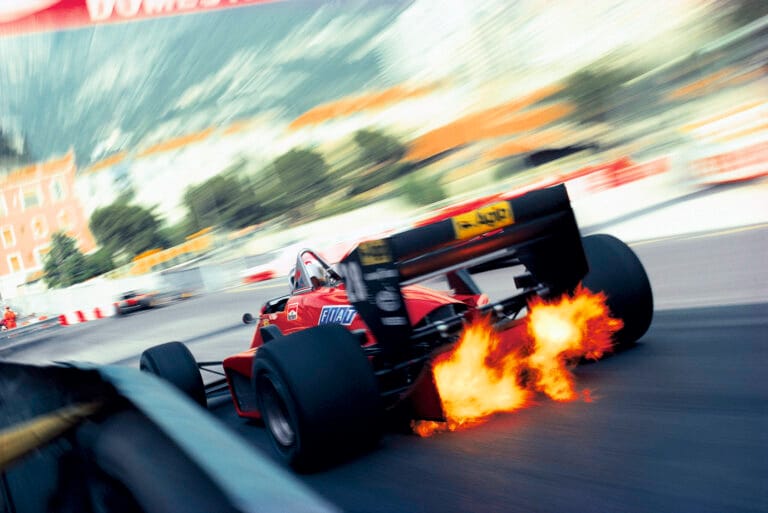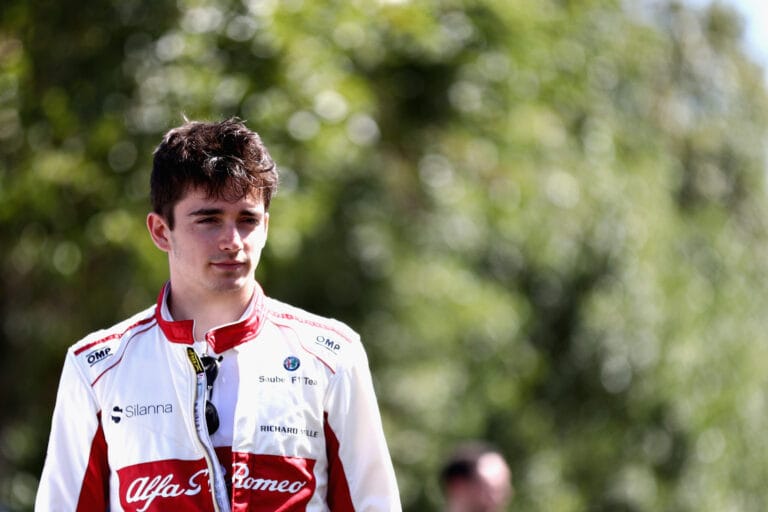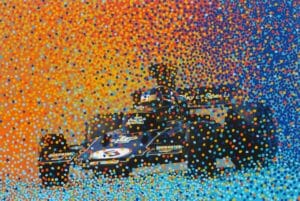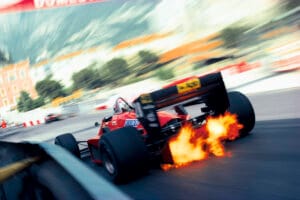The 1990 French Grand Prix marked the 42nd victory for Alain Prost. However, had the race been two laps shorter, Ivan Capelli would have claimed the win. In a Leyton House, designed by Adrian Newey, the Italian driver had previously failed to qualify. “My car was just left outside, even when it rained,” he recalls.
The 1990 season was dominated by the rivalry between McLaren-Honda and Ferrari. However, when these powerhouses faltered, Thierry Boutsen seized victory in Hungary in a Williams, seasoned pro Nelson Piquet managed to win the last two races of the season in a Benetton, and Jean Alesi nearly caused a sensation by tailing Ayrton Senna for several laps in a Tyrrell at Phoenix. For Ivan Capelli, in his third Formula 1 season, such a surprise seemed unlikely.
“Initially, the season seemed to be heading towards disaster,” Capelli recalls. “The car was unmanageable on most circuits. In Mexico and Brazil, both my teammate Mauricio Gugelmin and I failed to qualify.”
The Leyton House CG901 – the initials stand for Cesare Gariboldi, owner of the Formula 3000 team Genoa Racing and a good friend of Capelli – was designed by the then-young Adrian Newey. His views on aerodynamics were progressive at a time when the focus was primarily on engine power. However, little of his theory was realized in practice until Newey discovered a flaw in the correlation between the wind tunnel and reality, leading to a hasty modification of the cars.
The Power of the Diffuser
“The central tunnel of the diffuser was altered,” Capelli explains. “At that time, few people had a deep understanding of it. I didn’t fully grasp it either, but at Paul Ricard, the car was completely transformed. The diffuser generated so much downforce that we could lower the wings after every training session. In the end, we had almost no wing left, which made us nearly as fast as the McLarens and Ferraris on the straights. This was virtually impossible with our Judd engine, as the power difference was perhaps as much as a hundred horsepower.” Capelli qualified seventh, while Gugelmin started tenth.
Reminiscing the Race and Remembering Cesare Gariboldi
Capelli’s recollection of the race takes a detour to Cesare Gariboldi, his mentor who tragically died in a traffic accident in 1989. Gariboldi’s legacy lives on in the model designation of the Leyton House Formula 1 cars, and for good reason. “Without him, that team would never have existed, and I probably wouldn’t have made it to Formula 1,” says Capelli. “Despite having no money, Cesare let me drive in his Formula 3000 team. It was a small team. To give you an example: I had a major accident in Vallelunga, and to cover the repair costs, Cesare had no choice but to sell the team transporter. So, we had a perfectly fine race car again, but no way to transport it. Cesare arranged for another Italian team to pick up my car on their way to the races. At the circuits, there was no room for me in their tent, so my car was left outside, even when it rained.”
Bluffing His Way to Success
A year later, Capelli becomes champion in the Formula 3000 with Genoa Racing. Promotion to Formula 1 is not an obvious next step: Capelli still doesn’t have a sponsor. However, he receives an offer to race for Leyton House, a Japanese firm with sponsorship interests in motorsport, in Japan. After a few reasonably successful races, Capelli is presented with a contract for 1987. He bluffs about having a Formula 1 deal. “Of course, I didn’t have one, but Japan wasn’t on the radar of the Formula 1 teams at the time, and I didn’t want to disappear from sight.” The Leyton House boss then offers Capelli and Gariboldi a sponsorship deal in Formula 1 – how much would that cost? “Cesare casually mentioned a figure of four million dollars. We sealed the deal with a handshake and headed back to Europe, figuring we’d come up with something along the way.”
Adrian Newey: A New Approach to Formula 1
Instead of buying Capelli into an existing team with Akagi’s money, Gariboldi approaches Robin Herd. The founder of March has been out of Formula 1 for a few years, but is interested in a return to the top level. After a difficult start, Adrian Newey joins the team at the end of 1987. “The first car was a modified March Formula 3000 car, but the team realized that we needed to come up with something better, so we fully committed to a new car. Newey was tasked with designing it,” says Capelli. “It immediately became clear that he had a different approach. It was a time when turbo engines were gradually being phased out. Those cars had so much power that the rest was somewhat neglected. Adrian knew that there was a lot of gain to be made in the aerodynamics of cars.”
In 1988 and 1989, this belief is manifested through occasional successes of the turquoise-colored Leyton Houses, but in 1990 it seems Newey has missed the mark. “To translate the theory from the wind tunnel to practice, we had to set the car as hard as possible. This was at the expense of mechanical grip. Eventually, it turned out that the floor of the wind tunnel was bending, so all the data could be thrown away,” Capelli recalls. “Fortunately, Adrian was able to quickly come up with a new solution.”
Low Air Resistance
This pays off in France. After the start, the Leyton Houses seem to be able to keep up with the pace of the leaders. “Every time I came onto the straight, I saw the McLarens of Berger and Senna just diving into the first corner. In the morning we had decided to try to finish the race without a pit stop, so I knew I would be on the track before them when they made their pit stop. The only driver I overtook myself was Riccardo Patrese in the Williams. When everyone had made their pit stop, I was in first place, with Mauricio behind me.”
It’s an unprecedented sensation: the two Leyton House drivers have been nothing more than mobile chicanes in the 1990 season, if they even managed to qualify for the races. Suddenly, the duo is leading. “Prost was faster than me, but because he was racing for the championship I knew he wouldn’t take too many risks to overtake us. Unfortunately, Mauricio’s engine broke down, so I was left alone.” The Ferrari is getting closer, but the sleek Leyton House has so little air resistance on the long straight that the two hardly differ in top speed. “In the corners, Alain was faster, but because I lost one of my mirrors at the beginning of the race, I usually had no idea where he was.”
Warning Light Ignites
The blown engine of Mauricio Gugelmin turns out to be a harbinger, as with just two laps to go, the oil warning light on Capelli’s steering wheel flickers on. “I immediately eased off the gas, knowing what had happened to Mauricio. The engine started to falter more frequently, and that’s how Alain was able to easily overtake me,” Capelli recalls.
In the final lap, Capelli sits behind the wheel with crossed fingers, fearing that the fragile Judd V8 engine won’t hold up. “Towards the end, Ayrton Senna came very close, but I managed to keep him at bay. The second place was a fantastic result, but it left a bitter taste. What if I had won?” Capelli still wonders. “Leyton House was in financial trouble, and a victory might have solved that.”
A Flash in the Pan
The sensation at Paul Ricard turns out to be not a sign of success to come, but a one-off resurgence. That year, Capelli finishes seventh twice more, scoring no points. Gugelmin manages a sixth-place finish in Belgium, but that’s as good as it gets. In 1991, the duo drives again for Leyton House, but the magic is gone. “The car was again designed by Adrian Newey, but he already knew he was going to Williams, and little was done to the car during the season,” says Capelli. “I finished sixth in Hungary, but that was our only World Championship point that season. A year later, the team was bankrupt.”


